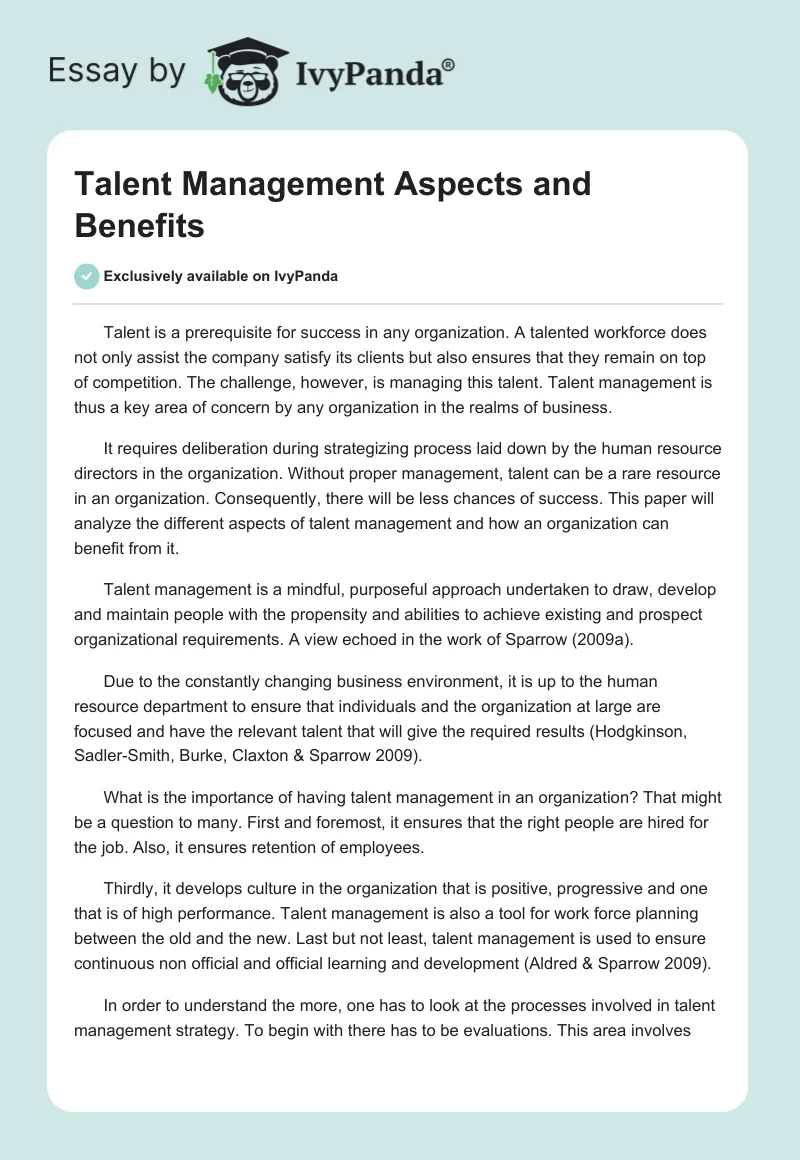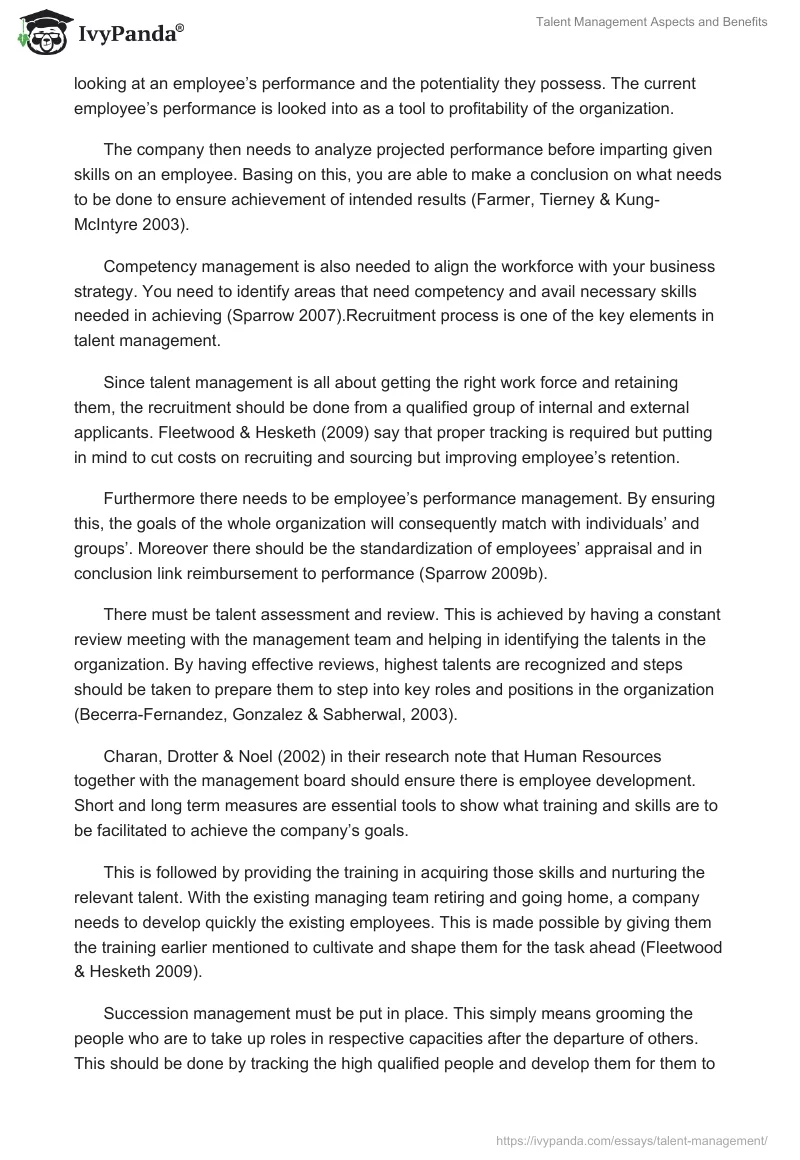Talent is a prerequisite for success in any organization. A talented workforce does not only assist the company satisfy its clients but also ensures that they remain on top of competition. The challenge, however, is managing this talent. Talent management is thus a key area of concern by any organization in the realms of business.
It requires deliberation during strategizing process laid down by the human resource directors in the organization. Without proper management, talent can be a rare resource in an organization. Consequently, there will be less chances of success. This paper will analyze the different aspects of talent management and how an organization can benefit from it.
Talent management is a mindful, purposeful approach undertaken to draw, develop and maintain people with the propensity and abilities to achieve existing and prospect organizational requirements. A view echoed in the work of Sparrow (2009a).
Due to the constantly changing business environment, it is up to the human resource department to ensure that individuals and the organization at large are focused and have the relevant talent that will give the required results (Hodgkinson, Sadler-Smith, Burke, Claxton & Sparrow 2009).
What is the importance of having talent management in an organization? That might be a question to many. First and foremost, it ensures that the right people are hired for the job. Also, it ensures retention of employees.
Thirdly, it develops culture in the organization that is positive, progressive and one that is of high performance. Talent management is also a tool for work force planning between the old and the new. Last but not least, talent management is used to ensure continuous non official and official learning and development (Aldred & Sparrow 2009).
In order to understand the more, one has to look at the processes involved in talent management strategy. To begin with there has to be evaluations. This area involves looking at an employee’s performance and the potentiality they possess. The current employee’s performance is looked into as a tool to profitability of the organization.
The company then needs to analyze projected performance before imparting given skills on an employee. Basing on this, you are able to make a conclusion on what needs to be done to ensure achievement of intended results (Farmer, Tierney & Kung-McIntyre 2003).
Competency management is also needed to align the workforce with your business strategy. You need to identify areas that need competency and avail necessary skills needed in achieving (Sparrow 2007).Recruitment process is one of the key elements in talent management.
Since talent management is all about getting the right work force and retaining them, the recruitment should be done from a qualified group of internal and external applicants. Fleetwood & Hesketh (2009) say that proper tracking is required but putting in mind to cut costs on recruiting and sourcing but improving employee’s retention.
Furthermore there needs to be employee’s performance management. By ensuring this, the goals of the whole organization will consequently match with individuals’ and groups’. Moreover there should be the standardization of employees’ appraisal and in conclusion link reimbursement to performance (Sparrow 2009b).
There must be talent assessment and review. This is achieved by having a constant review meeting with the management team and helping in identifying the talents in the organization. By having effective reviews, highest talents are recognized and steps should be taken to prepare them to step into key roles and positions in the organization (Becerra-Fernandez, Gonzalez & Sabherwal, 2003).
Charan, Drotter & Noel (2002) in their research note that Human Resources together with the management board should ensure there is employee development. Short and long term measures are essential tools to show what training and skills are to be facilitated to achieve the company’s goals.
This is followed by providing the training in acquiring those skills and nurturing the relevant talent. With the existing managing team retiring and going home, a company needs to develop quickly the existing employees. This is made possible by giving them the training earlier mentioned to cultivate and shape them for the task ahead (Fleetwood & Hesketh 2009).
Succession management must be put in place. This simply means grooming the people who are to take up roles in respective capacities after the departure of others. This should be done by tracking the high qualified people and develop them for them to assume leadership roles without any hitch. Identifying key positions and also potential personnel to take up position is necessary (Amabile & Khaire 2008).
When we work it is obvious that we are in search of payment at the end of the month. It is to this reason that compensation management is part of talent management. The management team should provide necessary compensation plans both from within and also look at the external packages in the market. This is aimed at offering the best package that will attract and retain the employees.
Finally there should be talent analyzing that will ensure you have the required skills and qualification. It also measures the effectiveness of the recruitment process, and looks at whether the learning program is effective or not. Further more; it looks at appropriateness of aligning employees goals to that of the organization not forgetting looking at cost effectiveness of the compensation programs.
It is important to note that for effective talent management, it has to start form the chief executive officers and the board of directors to the human resource department. This should incorporate the line managers who are always in direct contact with members of their departments (Brewster, Sparrow & Vernon 2007).
The scramble for talent as it is now will be effective in a company basing on effective recruitment and retention. The Human resource (HR) should ensure that there is a proper organizational channel to affect stability, stress on employer brand and status, have proper talent strategies, sustain multilevel responsibility, and get drawn in talent supervision initiatives and offer opportunities for career and individual development.
On recruitment and retention, the HR should ensure that there is a culture in place for employees to want to stay in the organization, channels for career development must be a priority, have a pool for successors at each stage, and identify any gaps in the company that will need special skills and is not yet filled up. It’s therefore the managements work to ensure that the appropriate talent is recognized and retained in line with the organizations goals and strategies.
Rob and Ben (2008) say that, for successful talent management the following aspects will be influential. One, there is need to have a supple talent sourcing. There is need to also have modified rewards. This not withstanding well spread out and significant leadership should be put in place. Lastly, we need a culture in the workplace that is in agreement with each other.
Incase of departure of a talented employee, it turns out that there is a problem which must be addressed. The HR must look at what the cause is and seal the loopholes. Loosing a talented employee who has been trained and groomed to take up position in the organization is like making a loss. It’s for this reason that the HR should be monitoring the behavioral changes of the talented employees and look for signs that might be suggesting a walk out from the company, and make sure that it doesn’t happen (Jeanne & Willyerd 2010;Schein 1977).
Many at times, a company will find itself in a crisis where there is a shortage of employees and there are those who opt to go for greener pasture. The problem is usually the lack of constant review of the talent. There is also the lack of response to the needs of having more talent. Another notable problem is not supporting the employee especially the first month of his work (Kee, 1997). Lastly, the company might not be having good knowledge about the employee. With these, it is obvious that the organization ends up loosing on its talent.
Therefore to ensure that an organization doesn’t loose on its talent, proper database should be in place to know what exactly is taking place. A sentiment supported by William (2008). Where there is need for appraisals it should be effected with the needs of the company. The database will also lay out exactly what kind of skill is needed and in what area. This will enable the management know on when to make recruitments internally and externally hence wont have a shortage of employees.
A well coordinating group from the chief executive officer (C.E.O) to the subordinates also helps in retaining of the necessary talent (Sparrow 2010; Hesketh 2006).
There will be knowledge of what is taking place in the company and so smooth running of the company. It’s the work of the HR to provide the c.e.o with the relevant information regarding the recruitment and retention process. Constant review together will provide with the avenue of seeing what is needed in order to be in competition with the global market that are not in sleep.
In winding up, to continue having excellent business results in the so much competitive business world, organizations need to go back to the drawing board and come up with appropriate ways in handling talent management. For it to work there must be a strong leadership, a culture of recruiting and retention, employee participation in inventions and suggestions and lastly to have a measurable mechanism to know how the progress and success is. This will make a company stay in the competition and win.
Reference List
Aldred, G. and Sparrow, P.R., 2009. International Mobility: Impact of the Current Economic Climate. Global Relocation Trends Report. London: Brookfield Global Relocation Services.
Amabile, T. M. and M. Khaire. 2008. Creativity and the role of the leader. Harvard Business Review, October, pp. 100-109.
Becerra-Fernandez, I., A. Gonzalez and R. Sabherwal., 2003. Knowledge Management. Boston: Prentice Hall.
Brewster, C, Sparrow, P.R. & Vernon, G., 2007. International human resource management. 2nd Edition. London: Chartered Institute of Personnel and Development.
Charan, R. Drotter, S. & Noel, J., 2002. The leadership pipeline: How to build the leadership powered company. San Francisco: Jossey Bass.
Farmer, S. M., P. Tierney and K. Kung-McIntyre. 2003. Employee creativity in Taiwan: An application of role identity theory. The Academy of Management Journal, 46(5), pp. 618-630.
Fleetwood, S. & Hesketh, A. 2009 Understanding the performance of human resources, Cambridge: Cambridge University Press.
Hesketh, A.J., 2006. Outsourcing the HR Function: Possibilities and Pitfalls, London: Accenture/CRF
Hodgkinson, G., Sadler-Smith, E., Burke, L., Claxton, G. & Sparrow, P.R., 2009.
Intuiton in organisations: Implications for strategic management. Long Range Planning. 42 (3): 277-297.
Jeanne C. M. and Willyerd, K., 2010. The 2020 Workplace: How Innovative Companies Attract, Develop and Keep Tomorrow’s Employees Today. New York: Harper Business.
Kee, P. J., 1996. Leading Change. Boston: Harvard Business School Press.
Rob, S and Ben E. D., 2008. Strategy-driven talent management: A leadership imperative. Broomall, PA: Chelsea publishers.
Schein, E., 1977. Increasing Organizational Effectiveness through Better Human Resources Planning and Development. Sloan Management Review, 19 (1), p. 1.
Sparrow, P.R., 2007. Globalisation of HR at function level: Four case studies of the international recruitment, selection and assessment process, International Journal of Human Resource Management, 18 (5), pp.144 -166.
Sparrow, P.R., 2009a. Handbook of international human resource management: integrating people, process and context. Chichester: Wiley.
Sparrow, P.R., 2009b. International reward management. In G. White & J.Drucker (Eds.), Reward management – a critical text. London: Routledge. pp. 233-257.
Sparrow, P.R., 2010. The Innovation Imperative: Charting the Territory for HR. Centre for Performance-led HR White Paper 10/01. Lancaster University Management School.
William. J. R., 2008. Effective succession planning. Ensuring leadership continuity and building talent. West port, CT: Airtime publishing Inc.


